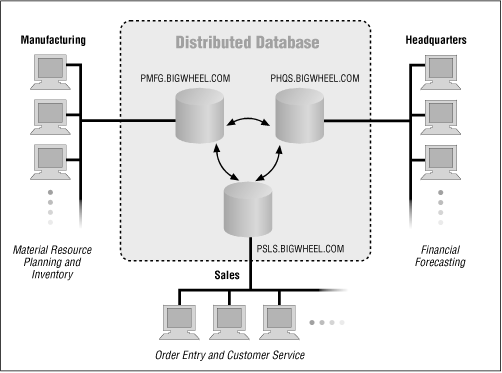A distributed database system, illustrated in Figure 1.3, is an environment in which data in two or more database instances is accessible as though this data were in a single instance. This access may be read-only, or it may permit updates to one or many instances. The referenced data may be real time, or it may be seconds, hours, or days old. Generally, the different database instances are housed on different server nodes, and communication between them is via SQL*Net (for Oracle7) or Net8 (for Oracle8). Chapter 2, describes this communication.
In addition to database servers, a distributed database system usually includes application servers and clients. The focus of this book is on the interaction among database servers, but a brief review of the entire distributed environment will clarify their raison d'être.
Application servers, like database servers, typically are high-capacity machines that run intensive utilities such as web applications, Oracle’s application cartridges, report generators, and so forth.
The clients in this environment are typically PCs or Macintoshes or other lightweight computers running web browsers. The client’s role is to provide an interface to the user, such as Forms (in Oracle Developer 2000) and web browsers. Client machines are characterized by low cost and the absence of a local database.
Implicit in this distributed system architecture is the network . It links database servers, application servers, and clients. SQL*Net and Net8 are network interfaces that are protocol-independent and that provide communication to networked databases.
Get Oracle Distributed Systems now with the O’Reilly learning platform.
O’Reilly members experience books, live events, courses curated by job role, and more from O’Reilly and nearly 200 top publishers.


